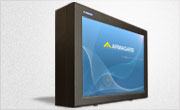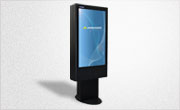The Changing Face of Television
Posted by: Richard Williams | Posted on: | 0 Comments
Few people don’t own a television, and modern flat screens don’t just provide us with entertainment but are found out of the home used in digital signage and other technology, but it has taken over a century for televisions to have developed into the modern LCD high definition screens we enjoy today.
Television has its roots in the latter part of the nineteenth century when a young German, Paul Nipkow patented the first television system, which employed a spinning disk full of slots where an image was produced by horizontal slices. Nipkow’s television could only produce still images, however, and it wasn’t until Russian scientist Boris Rosing used a cathode ray tube—a vacuum tube containing a source of electrons and a fluorescent screen—where moving images possible.
Often seen as the inventor of the modern television, Scotsman, John Logie Baird’s demonstration of a scanning disk produced a discernable image of a human face.
Several innovations and combinations of these televisions systems brought rise to the first mass-produced systems and broadcasting began with the 1938 Olympic Games being broadcast live across Berlin, while in the UK, the BBC began the first regular broadcasting service in 1936.
The outbreak of the Second World War pretty much halted television in its infancy with the BBC ceasing broadcasting and mass production of televisions in the United States halting. Television production and broadcasting began again in earnest following the end of the war with American commercial networks beginning broadcasting in 1947.
The following decades saw further developments in television, including the introduction of color, video recorders allowing users to play their own content, and then the development of flat screen devices such as the LCD and plasma screen.
Now, nearly all TVs used are flat panel screen with new technologies like high definition and digital programming making the old CRT and analogue services obsolete. Over the last decade, a huge increase in televisions used out of the home as seen the rise of digital signage, where user-generated narrowcast content provides advertising, promotion and branding in a wide range of locations.
Post shortlink:
Popular Products
LCD Enclosure
Need armor for your LCD/LED screen(s)? Outdoors or inside the versatile LCD enclosure protects against thieves, vandals & the weather. Installation idea: NFL stadiums.
Outdoor Digital Signage
Exclusive 46” outdoor screen protection. Dubbed the ‘Totem’, due to its distinct design, it repels damage threats, but attracts audiences. Installation idea: Drive-thru restaurants.
Portrait Flat Panel Enclosure
Safeguard your eye-level advertising display screen(s), indoors or outdoors. Completely customizable, add exciting features like touch screen technology. Installation idea: Restaurant frontages.
Indoor Digital Signage
Popular purchase for retail outlets! Great for ‘point of sale’ persuasion, boost your brand with static & motion advertising from a single unit! Installation idea: Mall of America.




